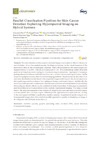Identificador persistente para citar o vincular este elemento:
https://accedacris.ulpgc.es/handle/10553/75354
| Título: | Parallel classification pipelines for skin cancer detection exploiting hyperspectral imaging on hybrid systems | Autores/as: | Torti, Emanuele León Martín, Sonia Raquel Salvia, Marco La Florimbi, Giordana Martínez Vega, Beatriz Fabelo, Himar Ortega, Samuel Callicó, Gustavo M. Leporati, Francesco |
Clasificación UNESCO: | 3307 Tecnología electrónica | Palabras clave: | Cancer Detection Graphic Processing Units Hyperspectral Imaging Multicore Cpu Real-Time Systems |
Fecha de publicación: | 2020 | Publicación seriada: | Electronics (Switzerland) | Resumen: | The early detection of skin cancer is of crucial importance to plan an effective therapy to treat the lesion. In routine medical practice, the diagnosis is based on the visual inspection of the lesion and it relies on the dermatologists’ expertise. After a first examination, the dermatologist may require a biopsy to confirm if the lesion is malignant or not. This methodology suffers from false positives and negatives issues, leading to unnecessary surgical procedures. Hyperspectral imaging is gaining relevance in this medical field since it is a non-invasive and non-ionizing technique, capable of providing higher accuracy than traditional imaging methods. Therefore, the development of an automatic classification system based on hyperspectral images could improve the medical practice to distinguish pigmented skin lesions from malignant, benign, and atypical lesions. Additionally, the system can assist general practitioners in first aid care to prevent noncritical lesions from reaching dermatologists, thereby alleviating the workload of medical specialists. In this paper is presented a parallel pipeline for skin cancer detection that exploits hyperspectral imaging. The computational times of the serial processing have been reduced by adopting multicore and many-core technologies, such as OpenMP and CUDA paradigms. Different parallel approaches have been combined, leading to the development of fifteen classification pipeline versions. Experimental results using in-vivo hyperspectral images show that a hybrid parallel approach is capable of classifying an image of 50 × 50 pixels with 125 bands in less than 1 s. | URI: | https://accedacris.ulpgc.es/handle/10553/75354 | DOI: | 10.3390/electronics9091503 | Fuente: | Electronics (Switzerland)[EISSN 2079-9292],v. 9 (9), p. 1-21, (Septiembre 2020) |
| Colección: | Artículos |
Citas SCOPUSTM
22
actualizado el 08-jun-2025
Citas de WEB OF SCIENCETM
Citations
19
actualizado el 08-jun-2025
Visitas
111
actualizado el 14-oct-2023
Descargas
109
actualizado el 14-oct-2023
Google ScholarTM
Verifica
Altmetric
Comparte
Exporta metadatos
Los elementos en ULPGC accedaCRIS están protegidos por derechos de autor con todos los derechos reservados, a menos que se indique lo contrario.
